
In the digital age, the protection of personal information, including knowing how to check the dark web for personal information, is more critical than ever.
With the prevalence of cyber threats and data breaches, it’s essential to take proactive steps to ensure your data’s security.
The “dark web” often harbors stolen personal information, making it a potential source for individuals to check whether their data has been compromised.
While accessing the dark web comes with risks, understanding how to navigate it safely can be valuable in securing your digital footprint.
Understanding the Dark Web:
The internet comprises three main layers: the surface web, the deep web, and the dark web.
The surface web includes websites indexed by search engines, while the deep web encompasses unindexed pages like private databases and password-protected sites.
The dark web, however, requires special software to access and operate anonymously, fostering activities both legal and illegal.
Steps to Check the Dark Web for Your Personal Information
Evaluate Risks and Precautions
Accessing the dark web involves risks like encountering illegal activities or malicious content.
Consider using a reputable virtual private network (VPN) and a secure browser like Tor to mask your identity and protect against potential threats.
Utilize Reputable Tools
Several legitimate platforms and tools exist to help users check if their data is on the dark web.
Services like Have I Been Pwned, CyberNews or Privacy Rights Clearinghouse provides databases where individuals can search for their compromised credentials.
Monitor with Caution
Regularly monitor your accounts and personal information for any suspicious activity.
Setting up alerts with credit monitoring services or using identity theft protection tools can notify you of potential breaches.
Change Passwords and Enable Two-Factor Authentication
If you find that your information is compromised, immediately change the passwords associated with the affected accounts.
Enable two-factor authentication whenever possible to add an extra layer of security.
Report and Take Action
In case of confirmed data breaches, report the incident to the respective platforms or authorities.
Consider freezing your credit or taking further measures to prevent identity theft.
Conclusion
Checking the dark web for your personal information can provide valuable insights into potential security vulnerabilities.
However, it’s crucial to approach this process cautiously, prioritizing your safety and privacy.
Continuously educating yourself on cybersecurity best practices and implementing robust security measures can significantly mitigate risks associated with data breaches and unauthorized access to your information.
Remember, prevention is critical in safeguarding your data.
Stay vigilant, employ strong security practices, and regularly monitor your online accounts to keep your personal information safe from cyber threats lurking in the depths of the internet.
FAQs
What exactly is the dark web?
The dark web is a part of the internet that is not indexed by traditional search engines. It requires special software like Tor to access and is known for its anonymity, hosting both legal and illegal activities.
How can I check if my personal information is on the dark web?
Several reputable tools and services exist, such as Have I Been Pwned, CyberNews, and Privacy Rights Clearinghouse, which allow individuals to search for their compromised credentials on the dark web.
Is it safe to access the dark web to check for my data?
Accessing the dark web comes with risks, including exposure to illegal content and cyber threats. It’s essential to use reputable security measures like a VPN and Tor browser to protect your identity and device before attempting to access the dark web.
What should I do if I find my information on the dark web?
If you find your information compromised, change the passwords associated with affected accounts immediately. Enable two-factor authentication and consider reporting the incident to the relevant authorities or platforms. It’s also advisable to monitor your accounts regularly for any suspicious activity.
Can checking the dark web prevent identity theft?
While checking the dark web for your data can provide insights into potential security breaches, it’s just one part of a comprehensive approach to safeguarding your information. Implementing strong security measures, regularly monitoring accounts, and staying informed about cybersecurity best practices are crucial steps in preventing identity theft.
Are there any legal implications for accessing the dark web?
Accessing the dark web itself is not illegal, but engaging in unlawful activities or attempting to purchase illicit goods or services is against the law. Always ensure you’re following legal guidelines and using the dark web responsibly for legitimate purposes.
How frequently should I check the dark web for my personal information?
Regular monitoring is critical. While there’s no set timeframe, it’s advisable to check periodically, especially after significant data breaches or security incidents. Additionally, setting up alerts with credit monitoring services can help notify you of any suspicious activity.
Can I completely remove my information from the dark web?
Removing information from the dark web entirely can be challenging. However, promptly addressing security breaches, changing compromised credentials, and reporting incidents can help minimize the risks associated with your data being on the dark web.